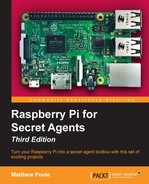Aha, good! Still with us, our sly grasshopper is! For our second day of spy class, we'll switch our gear of perception from sound to sight.
You're going to learn how to get the most out of your USB webcam or official Raspberry Pi camera module, secure your perimeter, and then end it on a high note with some mindless mischief. Specifically, we will:
- Take a look at the official Raspberry Pi Camera Module and how to connect it
- Use the camera module to take video and still images
- Connect webcams to the USB port, and capture video and still images
- Build a video surveillance and capture system with built-in motion detection
- Expand the video surveillance to support multiple cameras and remotely monitor it over the Internet
- Build a wearable covert video recording device using the Pi Zero
- Switch your TV on and off with scripts using the HDMI connection
Just as the ALSA system provides kernel drivers and a programming framework for your audio gadgets, there are two important components involved in getting your cameras to work under Linux:
- The Linux USB Video Class (UVC) drivers provide the low-level functions for your USB webcam, which are in accordance with a specification followed by most webcams produced today.
- Video4Linux (V4L) is a video capture framework used by applications that record video from cameras, TV tuners, and other video producing devices. There's an updated version of V4L called V4L2, which we'll want to use whenever possible.
..................Content has been hidden....................
You can't read the all page of ebook, please click here login for view all page.
